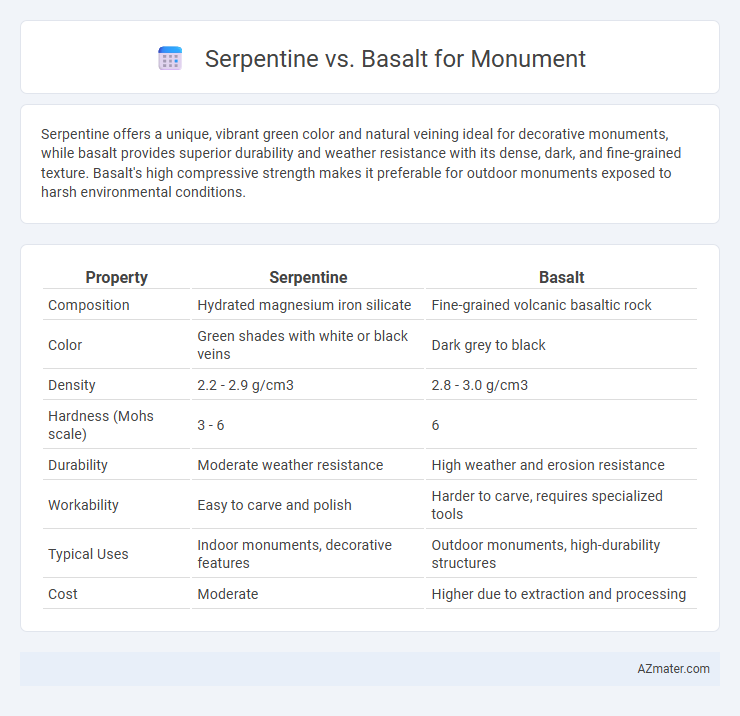Serpentine offers a unique, vibrant green color and natural veining ideal for decorative monuments, while basalt provides superior durability and weather resistance with its dense, dark, and fine-grained texture. Basalt's high compressive strength makes it preferable for outdoor monuments exposed to harsh environmental conditions.
Table of Comparison
| Property | Serpentine | Basalt |
|---|---|---|
| Composition | Hydrated magnesium iron silicate | Fine-grained volcanic basaltic rock |
| Color | Green shades with white or black veins | Dark grey to black |
| Density | 2.2 - 2.9 g/cm3 | 2.8 - 3.0 g/cm3 |
| Hardness (Mohs scale) | 3 - 6 | 6 |
| Durability | Moderate weather resistance | High weather and erosion resistance |
| Workability | Easy to carve and polish | Harder to carve, requires specialized tools |
| Typical Uses | Indoor monuments, decorative features | Outdoor monuments, high-durability structures |
| Cost | Moderate | Higher due to extraction and processing |
Introduction to Serpentine and Basalt
Serpentine is a greenish, metamorphic rock composed primarily of serpentine group minerals, known for its smooth texture and rich color variations, making it a popular choice for ornamental monuments. Basalt is a dark, fine-grained igneous rock formed from rapid cooling of lava, valued for its durability and dense composition, ideal for monumental structures exposed to harsh weather. Both stones offer unique aesthetic and physical properties, influencing their selection in monument design based on geological origin and intended use.
Geological Origins and Formation
Serpentine forms through the metamorphic alteration of ultramafic rocks, primarily peridotite, under hydrothermal conditions at relatively low temperatures and pressures in subduction zones. Basalt originates from rapid cooling of mafic lava at or near Earth's surface, produced by partial melting of the upper mantle at divergent plate boundaries or hotspots. The distinct formation processes result in serpentine's characteristic greenish, fibrous texture contrasting with basalt's fine-grained, dense, and dark appearance suitable for durable monuments.
Physical and Chemical Properties
Serpentine exhibits a green to dark green color range with a Mohs hardness of 2.5 to 5, making it softer and easier to carve compared to basalt, which has a hardness of 6 and ranges in color from black to dark gray. Chemically, serpentine is a magnesium iron silicate with a layered, foliated texture contributing to its sheen and relative porosity, while basalt is a dense, fine-grained volcanic rock composed mainly of plagioclase and pyroxene minerals, offering superior durability and resistance to weathering. The higher compressive strength and lower permeability of basalt make it a preferred choice for outdoor monuments exposed to harsh conditions, whereas serpentine's unique patterns and polishability provide aesthetic advantages for indoor or less exposed monuments.
Aesthetic Qualities and Color Variations
Serpentine exhibits a rich palette of greens, ranging from olive to deep emerald, often featuring marbled or mottled patterns that enhance its decorative appeal for monuments. Basalt, in contrast, presents a uniform, fine-grained texture with dark gray to black hues, offering a sleek, modern aesthetic with subtle variations that emphasize durability and strength. The choice between serpentine and basalt hinges on desired visual impact: serpentine provides vibrant color nuances, while basalt delivers a minimalist, timeless elegance.
Durability and Weather Resistance
Basalt exhibits superior durability and weather resistance compared to serpentine, making it a preferred choice for monuments exposed to harsh environmental conditions. Its dense, fine-grained structure resists erosion, abrasion, and chemical weathering more effectively than serpentine, which is softer and prone to surface degradation over time. Monuments crafted from basalt maintain structural integrity and aesthetic appearance longer, ensuring longevity in outdoor settings.
Workability and Carving Ease
Serpentine offers superior workability and carving ease compared to basalt due to its softer composition and finer grain structure, allowing detailed sculpting with less effort. Basalt's dense, hard nature makes it more durable but challenging to carve, requiring specialized tools and more labor-intensive techniques. Artists and monument makers prefer serpentine for intricate designs while basalt is favored for its resilience and weather resistance in enduring monuments.
Cost Considerations and Availability
Serpentine, often sourced from limited regional deposits, tends to have a moderate cost due to its unique green hues and relative rarity, making it a premium option for monuments. Basalt, widely available and commonly quarried, generally offers a lower and more stable price point, which is advantageous for budget-sensitive projects. The choice between serpentine and basalt for monuments hinges on balancing the desired aesthetics against the material's market availability and associated costs.
Environmental Impact and Sustainability
Serpentine and basalt differ significantly in environmental impact and sustainability for monument construction; serpentine extraction often involves lower carbon emissions due to its softer nature, reducing energy consumption during quarrying. Basalt, being a dense volcanic rock, offers exceptional durability and longevity, which minimizes the need for frequent replacements and contributes to sustainable monument preservation. Choosing between serpentine and basalt hinges on balancing the immediate environmental footprint of extraction with long-term sustainability benefits in monument durability.
Famous Monuments Made from Serpentine and Basalt
Serpentine and basalt are both popular choices for monuments due to their durability and unique aesthetics, with serpentine known for its rich green hues and smooth finish, while basalt offers a striking dark, volcanic appearance. Famous monuments made from serpentine include the Green Mountain Cemetery in Vermont, noted for its elegant gravestones and sculptural details, whereas basalt features prominently in the basalt columns of the Giant's Causeway in Northern Ireland, an iconic natural monument celebrated for its striking geometric formations. Both materials emphasize longevity and natural beauty, making them favored in historical and contemporary monument design.
Choosing the Right Stone for Your Monument
Serpentine offers a unique green hue and graceful veining, making it suitable for monuments that emphasize aesthetic appeal and individuality. Basalt provides exceptional durability and a deep black color, ideal for monuments requiring longevity and a dramatic, somber tone. Selecting the right stone depends on balancing desired visual impact with weather resistance and maintenance demands.

Infographic: Serpentine vs Basalt for Monument
 azmater.com
azmater.com